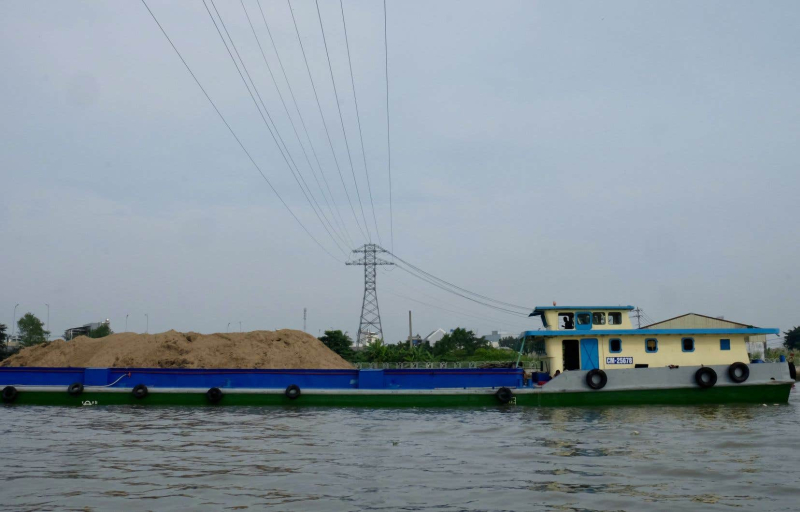
Photo: Éric Desrosiers Le Devoir Barges loaded with sand on the Bassac River, one of the main branches of the Mekong, in the delta
Eric Desrosiers to Can Tho
February 12, 2024
- Asia
Born from the union of land and water, the Mekong Delta is today threatened with disappearance, victim of the lack of attention paid to the fragile and complex functioning of nature. Second article in a series of four.
At first glance innocuous, sand is at the heart of Vietnam's extraordinary economic growth and the catastrophe facing the Mekong Delta.
No need to wait long to see a barge loaded with sand pass through the Mekong Delta. The long boats and their floating dunes are constantly going up and down the water towards a new tower to be built which needs concrete and another road to be widened which needs foundations.< /p>
This spectacle would be rather heartening if it were just another proof of the country's dizzying development in recent years and the efforts made to meet its pressing need for more infrastructure. Unfortunately, it is also the result of unbridled extraction of the sand on which the Mekong Delta was built over the millennia, and without which it now risks disappearing.
The problem perhaps comes first from the fact that we generally think that sand has no value, observes Marc Goichot, head of the water program at the World Wide Fund for Nature (WWF) for the Asia-Pacific which has produced several research studies on the overexploitation of this resource. “Economically, [the sand] is worth nothing other than the cost of extracting it and transporting it. »
Also read
- A paradise lost in Vietnam… by humans
- Hard times for environmentalists in Vietnam
Sand, gravel and aggregates are, however, the second most exploited natural resources in the world after water, reports the United Nations Environment Program. And the use of these materials has tripled over the past two decades, to between 40 and 50 billion tons per year.
In the Mekong Delta, sand is taken in particular from the beds of rivers and their banks where the current has deposited it at the end of a long journey beginning at the sources of the great river in the Himalayas. But now, the numerous concrete dams erected upstream now retain four-fifths of the sand that would have naturally been deposited. As this new supply is 14 to 17 times less than what is extracted each year, the WWF recently estimated that all sand reserves in the Mekong Delta will be exhausted by 2035.
A crumbling armor
The matter is not only a problem for the construction of buildings, ports, bridges and roads. This sand, like the sediments that are also collected in the extraction process, “is the framework and armor” of the Mekong Delta. However, by digging the beds of watercourses, we accelerate the erosion of their banks and we encourage the entry of sea water deeper and deeper into the land.
As less sand is transported to the sea, the delta also sees the disappearance of the natural protection against storms offered by the sandbanks which form up to thirty kilometers from its coasts, warns Nguyen Huu Thien , an international expert and consultant. To protect against rising sea levels and their onslaughts during the typhoon season, there has been a tendency to build dikes – particularly concrete ones – but this also has the effect of further reducing the capacity of the courses. of water to convey its natural defense mechanism to the coast.
“In fact,” says Marc Goichot, “the greatest value of sand in the Mekong Delta — even from a strict economic point of view — is to leave it where it is. There is no better, more effective or more cost-effective protection against climate change. »
The fight is organized
Increasingly aware of the seriousness of the situation, the authorities began by putting an end to the export of sand, among others to Singapore. They also began, for the first time, to measure their sand reserves and began to reserve their use for “critical projects”.
Engineers and contractors will need to learn new construction techniques, experts say. We are talking in particular about building highways at height in order to reduce the quantity of sand and aggregates necessary in addition to reducing the weight exerted on territories which are already prone to subsidence in the Mekong Delta.
Authorities have also declared war on illegal sand mining. This fight, however, proves difficult and suffers from privileges, namely the number of barges which are loaded with sand as if by magic at night. It must be said, reports the local press, that after the arrest of 18 people involved in this illegal trafficking this summer, the price of sand immediately jumped and many construction projects had to be stopped.
This report was financed with the support of the Transat International Journalism Fund-Le Devoir.

